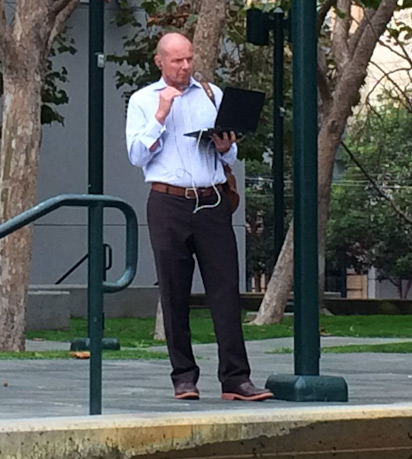During the day, in any given city, I can find a bench with a respectable amount of solitude. Not this week in San Francisco. There’s a huge, city-wide convention going on. Arriving at the Yerba Buena Gardens, I felt like a party crasher.
The convention is all about the cloud. It’s a concept that dominates the events I scribe – transferring our data to a remote and seemingly limitless repository.
But as I watched the people around me, I couldn’t help but wonder if we’ve transferred more than just our data. All around me, people seemed buried in their phones or laptops.
Griping about people on their phones, though, is pointless. It’s our new reality. I run the risk of looking as stodgy as this church does next to its sleek corporate neighbors.
But a funny thing happened as I sat and watched. After a while, up through the babble of tech conversations, other sounds emerged.
The laughter of a young mom.
A rake in the grass.

The enthusiastic greeting of a man to a dog.

A bird behind me, feeding on seeds.

And the one word that was said to me, spoken by the groundskeeper in the
hat who passed me when I picked up my paper that had blown to the
ground: “Thanks.”
They were all little vignettes of everyday life. Anchored in the real world.
In a strange way, art is like the cloud. A painting represents a world of information accessible through a small interface. But rather than being just a storage of content, retrievable when we need it, art calls us to engage that world. And be changed by it.
 |
| Another park pressed with people! |
I read recently a comment by Semir Zeki, a researcher in neuroaesthetics – a relatively new field of study of the effect of art on the brain. He observed, “The blood flow increased for a beautiful painting just as it increases when you look at someone you love.” Art challenges us to engage. It connects us with our common experiences.
It grounds us.
Though it does require slowing down to engage with it, art helps us keep our eyes and hearts open to the world around us.
Even if our future looks very cloudy.






























